The Best Time to Visit Georgia: Month by Month Comparison (original) (raw)
When is the best time of year to visit the country of Georgia? Find the answers you’re looking for in this month-by-month guide to weather in Georgia, seasonal activities, festivals, events and more.
Trying to figure out the ideal month (or even just the best season) to visit Georgia can be tricky. For such a tiny country, Georgia has a very diverse geography and climate – the east differs vastly to the west, while the different mountain regions and coast have their own microclimates.
This means there’s no definitive ‘best time to visit Georgia’: Every season offers something different.
Having said that, there are certainly months that are better suited to travel – and a few times of year you should try to avoid.
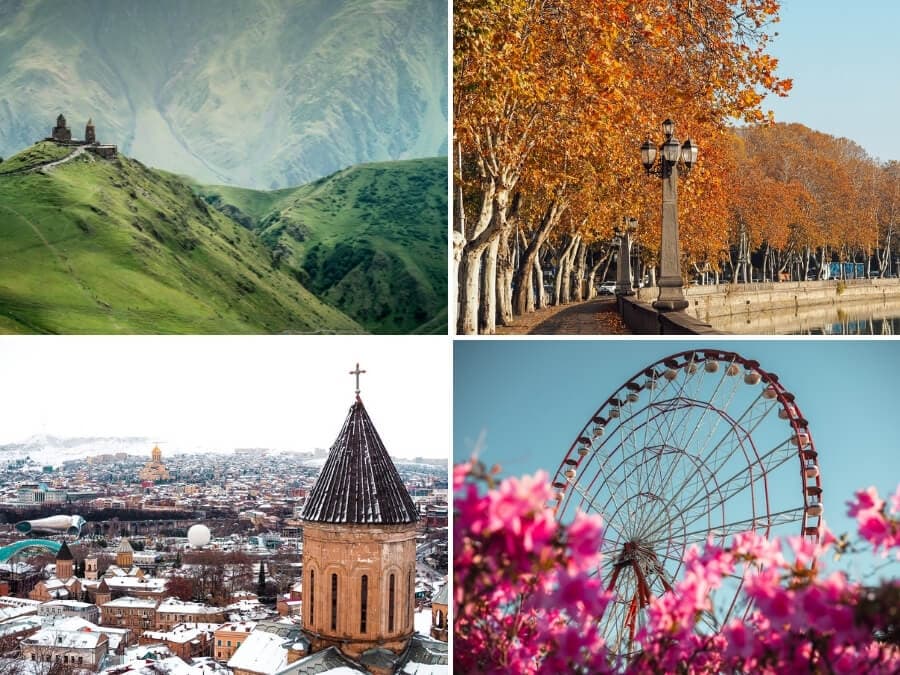
Four seasons in Georgia.
I’ve lived in Georgia for over three years now and have experienced every season. This guide draws on my knowledge to give you a seasonal overview and month-by-month breakdown of weather to help you decide the best time to travel to Georgia for your interests.
I’ll also cover the best places to visit in each season plus key festivals and events to plan your trip around.
Please note: This post contains affiliate links, meaning I may earn a commission if you make a purchase by clicking a link (at no extra cost to you). Learn more.
Travel Georgia Like a Pro
Planning a trip to Georgia? Here are 5 essential resources that I recommend you check out.
- For private transfers in Georgia: GoTrip.ge. Find a professional, English-speaking driver. Prices are locked in when you book & you can stop wherever you want.
- For hiring a car in Georgia: Local Rent. Save money when you rent directly from a local agent. Pick-up & drop-off are available from any address in Georgia.
- For finding accommodations: Booking.com. This website has the biggest selection of properties in Georgia, including guesthouses in rural areas.
- For Tbilisi tours & day trips: Friendly.ge. Friendly.ge has knowledgeable guides, safe drivers & creative itineraries. I especially like their off-road tour to David Gareja.
- For tailored advice: Book a call with me! My Georgia Travel Consultation service is perfect if you need feedback on your itinerary or personalised travel tips.
Understanding the climate in Georgia
I don’t want to dwell too much on this, but having a general understanding of Georgia’s climate can be useful.
Briefly, eastern Georgia has a Mediterranean-like climate, while the west of the country and Black Sea Coast has subtropical conditions. Tbilisi is dry, while Batumi and the coast are humid. As mentioned, the weather varies immensely from north to south, east to west.
There are four seasons in Georgia, but spring and autumn are generally short and pronounced. Summer lingers well into September in many parts of the country, while areas at higher elevations have prolonged winters. The major cities of Tbilisi, Kutaisi and Batumi are mild year-round (relatively speaking).
The east of Georgia (including Tbilisi and Kakheti region) is dry and sees more dramatic seasons: Summers are unforgiving and winters bitter. Parts of Southern Georgia (especially Samtskhe-Javakheti region) are under snow more often than not. The west of Georgia, by contrast, is warmer, wetter and more humid. Temperatures are more consistent here throughout the year, as are the menacing rain clouds.
One thing the whole country has in common is that the weather can be quite temperamental. Gusting winds can take the temperature up or down by 10 degrees Celsius in a matter of days, and storms and impenetrable fog can roll in extremely quickly.
While I can offer you some general guidance, you should always come prepared for anything!
Tip: This website is generally considered to be the most reliable for forecasts.
Tip: See my all-seasons Georgia packing list for guidance on what to bring with you and how to dress in Georgia.
Map of the best time to visit Georgia by location
Here is a rough map of popular destinations in Georgia with my recommendations for the ‘best’ time to go. Of course this is a bit subjective, but I’ve taken into account the average temperatures and rain fall, as well as special events and other factors.
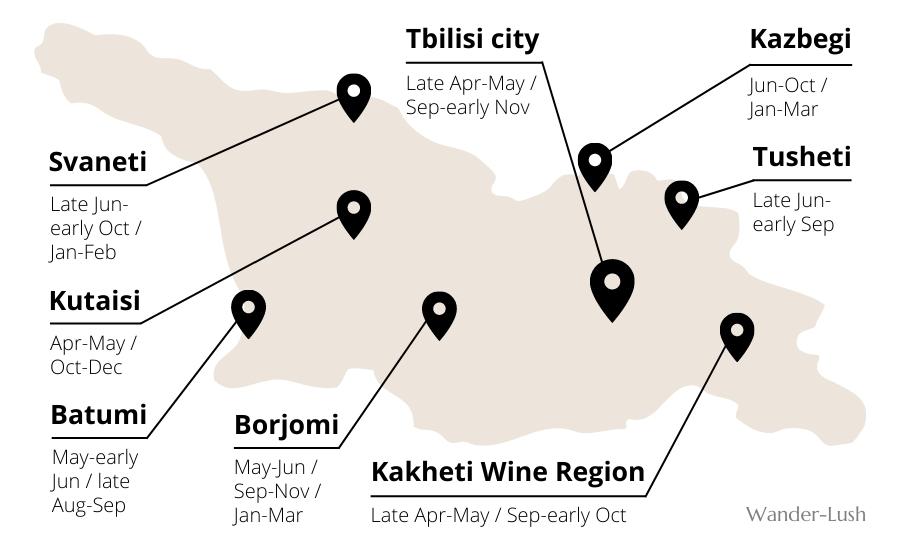
Map of the best time to visit the country of Georgia.
Summer high season in Georgia: Late June-early September
→ Best time for mountain hiking & beaches on the Black Sea coast.

Summer in Racha-Lechkhumi.
In Tbilisi and the lowlands around the capital, summer is dependably hot and arid. The landscape dries out to a crisp brown in early summer, and the unrelenting sunshine makes it difficult to stay outside for more than a few hours at a time.
The very warm weather (where temperatures can push 40 degrees Celsius in the shade for several consecutive days) generally sets in around mid-June and builds throughout July before peaking in August.
Most locals promptly leave the cities as soon as school holidays roll around in July, heading to the mountains or the coast for some reprieve. Because of this, popular hotels and resorts are often full, and domestic flights and trains sold out. It can be difficult to get a seat on the Tbilisi Batumi train especially. Prices go up with increased demand.
One advantage of summer travel is that the days are much longer (the sun sets well after 9pm by late June), so you can fit a lot more into your day.
Say no to sweaty marshrutka vans – summer is a great time for a Georgia road trip instead. All roads and passes are open and accessible, just watch out for flash flooding and landslides in the highlands.
Summer is prime time for trekking in the mountains of Svaneti and around Kazbegi. The wildflowers are out, and daytime temperatures are pleasant, while evenings bring short but punishing storms.
This is the best time of year to visit Tusheti, Khevsureti, Upper Adjara, Gomismta and Bakhmaro, which are all difficult (or impossible) to reach during the colder months.
In mid-September, ‘Velvet Season’ kicks off in Batumi and along the Black Sea coast and lasts until early October. This is a short window of time when crowds disperse but skies remain clear and the water is still warm enough to swim.
→ See my guide to beating the heat in Tbilisi in summer
Autumn shoulder season in Georgia: Late September-October
→ Best time for wine & cultural events.
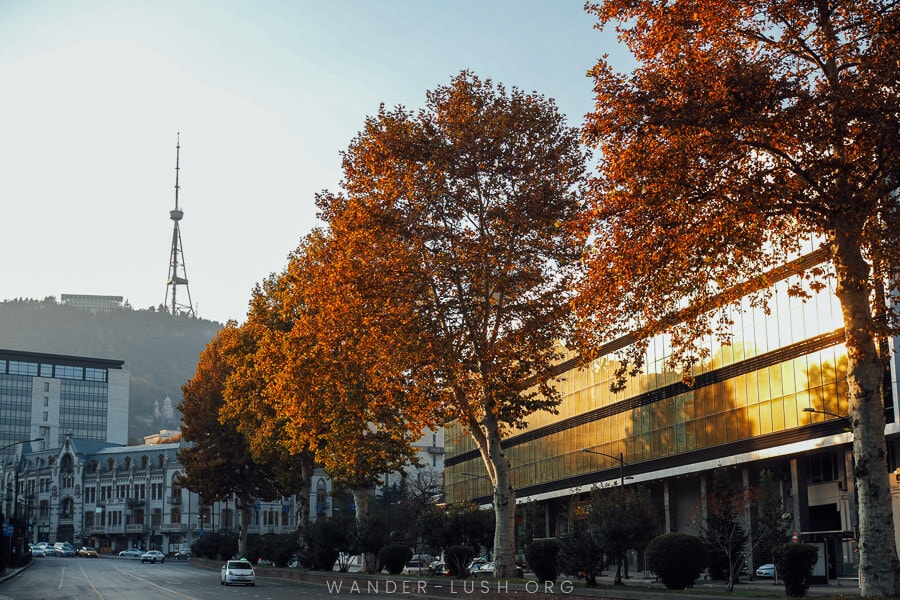
Autumn colours in Tbilisi.
September is sometimes referred to as the ‘fourth month of summer’ because temperatures remain warm in Tbilisi, Kutaisi and the lowlands. By mid-September and throughout the month of October, the weather is usually near perfect: Warm, breezy days, crisp nights, and clear skies. The only downside is the gusting winds that hit Tbilisi and Kutaisi – something to be mindful of if you suffer from allergies.
Autumn is my favourite time of year in and the best season to visit Georgia in my opinion. Tbilisi has an upbeat atmosphere, with outdoor markets on Rustaveli Avenue, the annual Tbilisoba festival in October, and plenty of live music, opera and ballet.
Harvest season brings a festive feel to the entire country – which is why you’ll sometimes hear autumn referred to by another name, the ‘fifth season’. Dates for the wine vintage or Rtveli differ year to year, but generally it takes place in Kakheti from early September and lasts until early November in western Georgia.
Resplendent fall foliage can be found in the highlands of Racha and Samegrelo from as early as September, while Tbilisi’s fall colours come into their own in October. Rust-coloured foliage is visible in areas such as Rkoni until November.
Autumn also brings a cornucopia of produce, including mushrooms, pomegranates and persimmons. Tbilisi restaurants often put on special menus to showcase fall’s bounty.
Most mountain areas and trails remain accessible throughout September and into early October.
→ See my guide to the best places to visit in Georgia in autumn
→ See my guide to the best things to do in Tbilisi in autumn
Winter low season in Georgia: November-March
→ Best time for winter sports or a quiet city break.
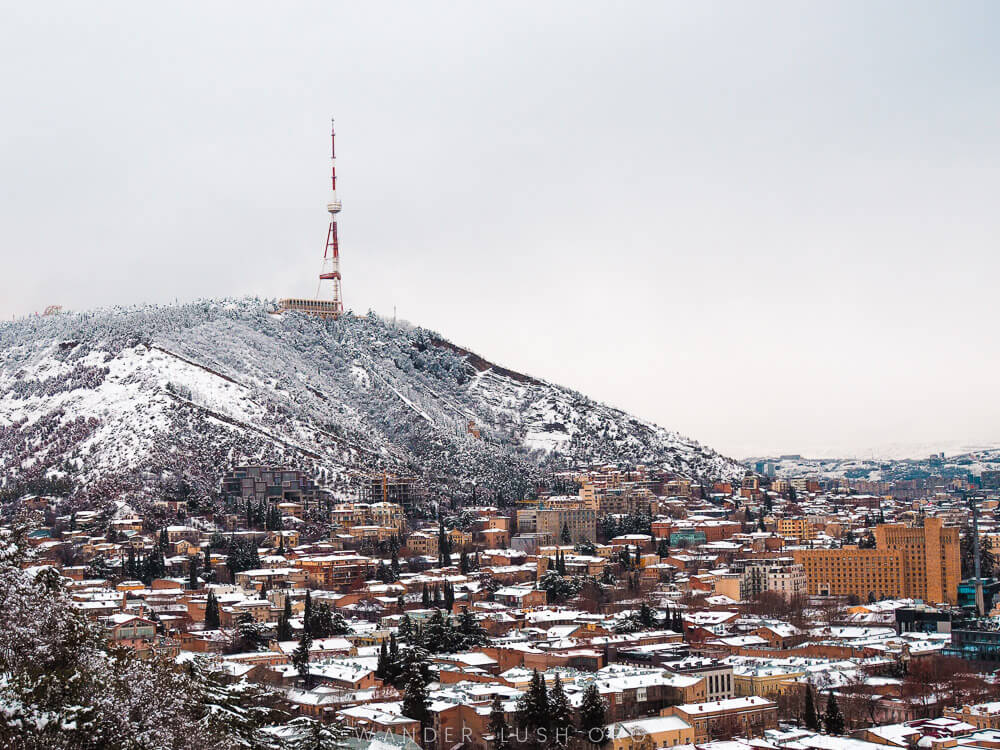
Winter in Tbilisi.
Relatively mild winters in Tbilisi make the city quite pleasant between November and March, especially when the sun is shining. Snow in Tbilisi is a rarity but there may be a few flurry days right at the end of the season, usually in late February or early March. With quiet streets, snug wine bars and the thermal baths at your disposal, Tbilisi is wonderful for a winter city break.
Conditions are freezing in the highlands, but mountain areas that are still accessible by road are a winter wonderland. The highways to Kazbegi and Svaneti remain open throughout winter (only closing temporarily in case of avalanche risk or heavy snow). Along with lower Racha, these mountain regions are the perfect place to snuggle up in a cosy cabin.
Winter sports season at Georgia’s ski resorts in Gudauri, Bakuriani, Goderdzi, Hatsvali and Tetnuldi usually starts from late December and runs through until April. It gets extremely busy in Gudauri and Bakuriani especially, so I don’t recommend staying here unless you are skiing.
→ See my guide to the best places to visit in Georgia in winter
→ See my guide to the best things to do in Tbilisi in winter
→ See my photos of snow in Tbilisi
→ See my beginner’s guide to skiing in Georgia
Spring shoulder season in Georgia: April-early June
→ Best time for hiking at lower elevations & exploring the cities.
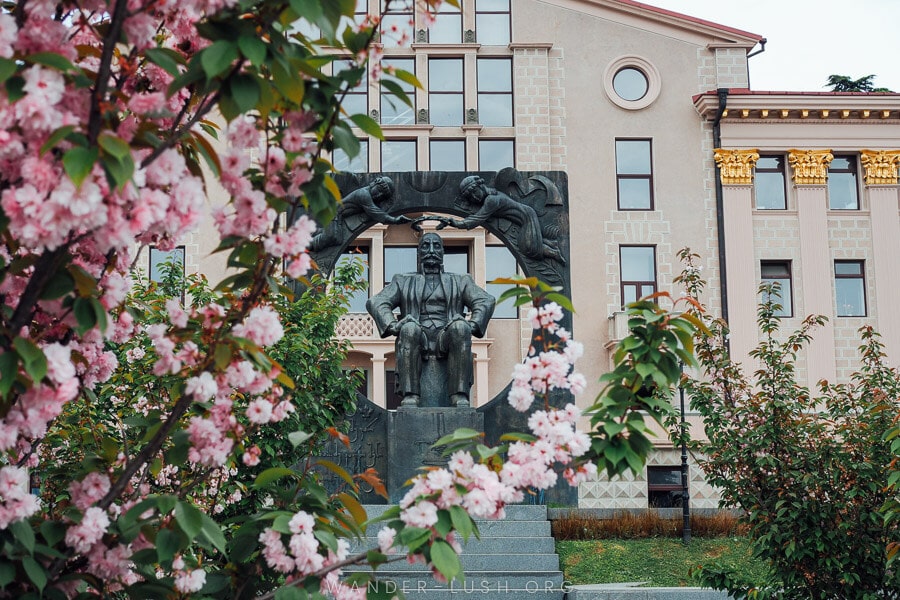
Spring in Batumi.
You know it’s spring in Tbilisi when powder-pink cherry, plum and magnolia blossoms start to appear. In Kakheti, lavender shrubs and sunflowers come into bloom, while wildflowers in the mountains take their turn later in June and July.
‘Moody March’ is very unpredictable all across the country, with gusting (pollen-laden) winds and sometimes snow. The start of April can still be quite chilly.
In the east of Georgia, the weather seems to shift towards being warm right after Orthodox Easter (I know that doesn’t make much sense since the dates change every year, but it just does!), while temperatures are already rising in Kutaisi and the west by mid-month. Nights remain pleasantly cool until early June. But rain is common in most parts of the country and can put a dampener on your plans.
Georgia’s rich Orthodox traditions are on full display in the lead up to Easter, while spring also brings vibrant produce and special foods such as chakapuli (lamb, sour plum and tarragon stew) and paska, a traditional Georgian cake.
Spring is the time when vintners open their clay qvevri for the first taste of last year’s harvest. This is a wonderful tradition to observe if you can organise to visit a cellar. The New Wine Festival and Zero Compromise Natural Wine Festival both take place in Tbilisi in May, drawing hundreds of winemakers from around the country for tastings and a food bonanza.
On the Black Sea Coast, spring is normally grey and wet. It’s still too brisk for any serious hiking in the Greater Caucasus. Instead, spring is better suited to hiking at lower elevations, e.g. around Borjomi and Lagodekhi national parks.
→ See my guide on where to go in Georgia in spring
→ See my guide to the best things to do in Tbilisi in spring
Now that you have a rough idea of the seasons in Georgia, here is a month-by-month breakdown of weather and conditions.
I’ve also included major holidays and events to look out for, plus my tips for where to go and where to avoid for each month of the year.

Traditional Chichilaki Christmas trees on display in Tbilisi in January.
January in Georgia
Temperatures in Tbilisi are relatively mild, hovering around 5-10 degrees Celsius during the middle of the day. Without the ice, sleet and drizzle typical of other European capitals, the city is quite pleasant throughout the month – especially on clear, crisp blue-sky days, of which there are many. The best way to warm up on a wintry evening is with a session at the sulfur baths.
Conditions are similarly cold but wetter in the west, while snowfall nears its peak in the mountains. High passes that close off in October/November remain inaccessible throughout winter, so this is not a time for hiking or visiting remote villages.
Orthodox Christmas falls a fortnight or so after Roman Catholic Christmas, meaning Georgia celebrates its second-biggest religious holiday in early January. Christmas is traditionally a time for family, but visitors can revel in December 31 celebrations.
As well as marking the International New Year, this is the biggest evening on the Christmas calendar (a hangover from Soviet times) and sees a massive fireworks display take over the streets of Tbilisi. Crackers and rockets spring from windows and street corners at every angle – you’ve never seen or heard anything like it.
January 2 is Bedoba, a unique tradition where one is obliged to treat oneself and others in order to set the tone for the year ahead. A wine tasting could be just the thing.
The Alilo Parade takes place on Orthodox Christmas Day (January 7) with a procession through the streets of Tbilisi. Orthodox Epiphany in mid-January designates the official end of the holiday season, and the decorations come down shortly before that.
Unique traditions can be observed in the mountains during winter, including Lipanali, a day-of-the-dead-like commemoration in Svaneti that starts on Epiphany eve.
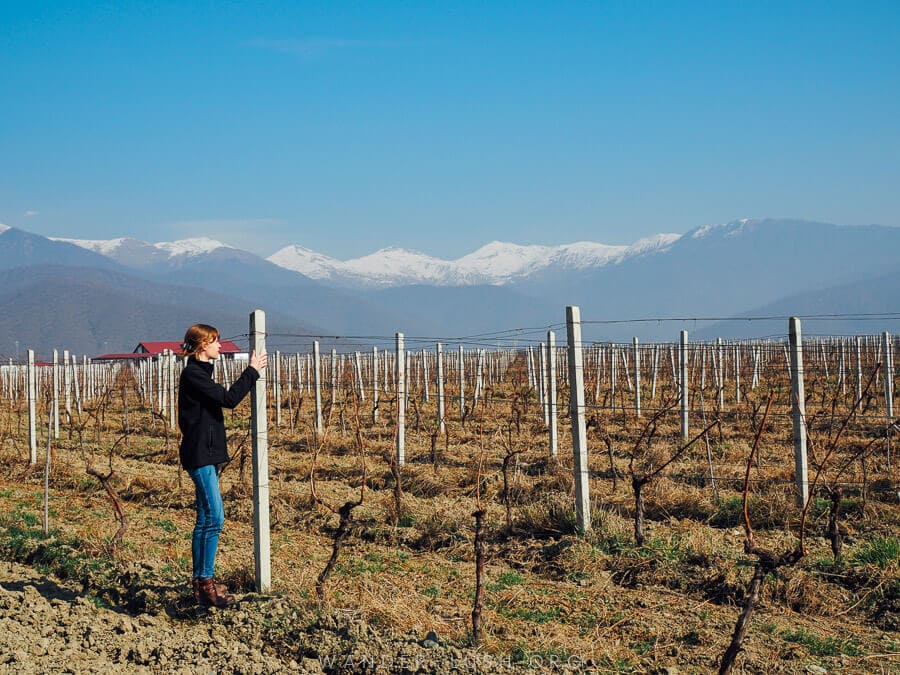
Clear skies and freshly pruned vines in Kakheti in February.
February in Georgia
February is cool and fresh in the cities. Or it could be grey and miserable. You never know!
Winter sports season really starts to take off on the slopes of Bakuriani and Gudauri in particular, making this a great time for skiing or snowboarding. Traditionally, Mestia and Gudauri both have their highest number of snowy days in February.
February is the coldest month of the year for most of the country so remember to pack your woollens. Snow has been known to fall in Tbilisi (and even Batumi) towards the end of the month – but it almost always melts away by nightfall.
This is a great month for riding the Kukushka train in Bakuriani (currently out of commission, sadly), snowshoe hiking, lounging in a natural hot spring, or viewing the stone towers in Ushguli on a bed of snow.

Snow in Gudauri in March.
March in Georgia
March (AKA ‘Mad March’ or ‘Moody March’) is a transition month in Georgia and the weather is normally very unpredictable as a result. Generally speaking, temperatures sit at around 7-12 degrees Celsius in Tbilisi, Batumi, Kutaisi and the lowlands, while the mountain regions are still frosty. But in reality you should expect anything: Storms, gusting winds, snow, sun – or all of the above!
Snowfall remains steady in Gudauri and Mestia before trailing off at the start of April, signifying the end of the ski season.

Cherry blossoms in Tbilisi.
April in Georgia
April puts a full-stop on winter and is the definitive start of spring in Georgia. The mercury rises above 10 degrees Celsius in the cities and stays there. Tbilisi and Kutaisi are both a little rainy. On the plus side, Tbilisi’s parks are festooned with cherry and magnolia blossoms, giving the city a cheery atmosphere.
Being a predominantly Orthodox country, Georgia celebrates Easter after the Roman Catholic calendar. In 2024, Easter Sunday falls on May 5, meaning preparations will be underway throughout the second half of April.
Red Friday, Great Saturday, Easter Sunday and Bright Monday are all public holidays. Easter culminates with midnight liturgy on the Saturday/Sunday, where you can hear resplendent chanting. For something truly special, head to Lanchkhuti in Guria region for Lelo Burti, a cultural festival based around a traditional full-contact ball game.
Easter is traditionally preceded by 40 days of fasting. Look out for paska fruit cake being sold at bakeries. Another tradition is dying eggs red with Madder root and displaying them at home with green wheatgrass. You’ll see these items sold on the streets in the lead-up to Easter.
If you suffer from allergies, be aware that there is usually a lot of pollen and floral debris in the air towards the end of spring.

Spring sunshine and new wines in Kakheti.
May in Georgia
May is a crowd-pleaser and another of the best times to go to Georgia, with generally pleasant weather, hiking trails available at lower elevations, and a peaceful tempo in the cities. The downside is that the weather can still be unpredictable so you need to plan for anything. May brings rain to much of the country.
Still, it’s a nice time to visit the arid parts of eastern Georgia, including Vashlovani National Park and David Gareja Cave Monastery as it’s not too hot yet. The road to Tusheti normally opens at the end of May or in the first week of June. Spring arrives earlier in Kutaisi and Batumi. On May 2, Kutaisi celebrates Kutaisoba.
Kakheti is particularly nice in May, with blossoming flowers, budding vines, and the ceremonial cracking of the previous year’s qvevri. In Tbilisi, the New Wine Festival is held every May at Mtatsminda park, bringing more than 200 winemakers to the capital to showcase their latest concoctions. The cultural celebration includes bottomless tastings, live music and food.
May 26 is Independence Day, when Georgia commemorates its split from the Russian Empire in 1918. Part of Rustaveli Avenue in Tbilisi is closed to traffic and an open-air street festival takes over, with pop-up restaurants and bars, live music and a market.
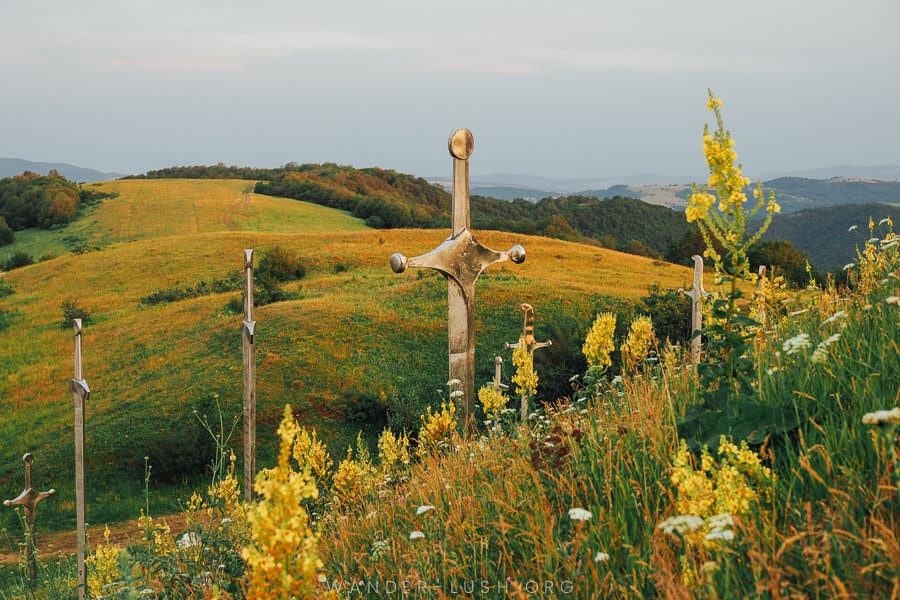
Summer wildflowers at Didgori.
June in Georgia
In most parts of the country, the first half of June feels like a continuation of spring. Temperatures become pleasantly balmy and it’s not too crowded yet, making this a nice time to visit the cities, coast and even popular mountain areas such as Svaneti – which is plastered with wildflowers come summer.
At some point (usually around mid-June) the weather changes rapidly and it gets very hot in the cities. Travelling in marshrutka vans is almost unbearable, so it’s a great time to hire your own car, taking advantage of the longer days to venture out to Georgia’s harder-to-reach corners.
More hiking trails become available, with trekking season officially on by the third or fourth week of June. The ski lifts in Gudauri open to summer visitors at the end of the month. Overall, the mountains are spectacular in June, making this the best time to rent a secluded cabin or go glamping.
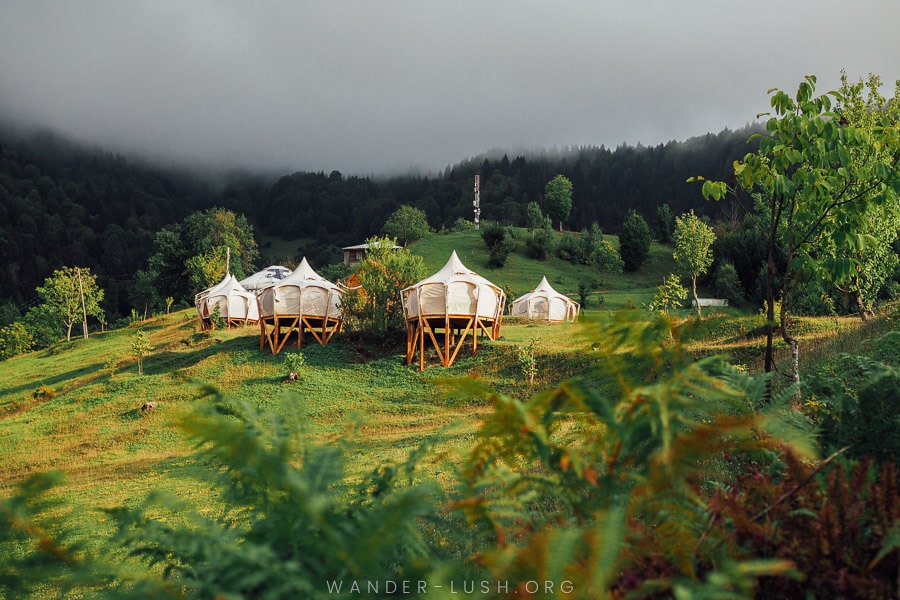
Summer glamping at Tago in Upper Adjara. Watch out for those storms!
July in Georgia
Things really start to heat up in July and by the middle of the month, temperatures in Tbilisi are pushing 40 degrees Celsius in the shade. Kutaisi is similarly hot but with the added bonus of humidity, while Batumi is slightly cooler thanks to the sea breeze, but much more crowded.
The dynamics of Tbilisi shift in July as local families depart for the villages or the coast and tourists flood the city in their place. It’s far too hot and dry in Tbilisi for my liking – the better move is to follow the locals’ example and escape to the mountains or to a lake.
Everyone has the same idea though, so accommodation prices can be inflated and availability limited during July and August. Summer resorts such as Abastumani, Sairme and Borjomi are at maximum capacity (as is Batumi), while the mountain regions of Racha and Upper Adjara are a nice alternative.
July is a great time in Georgia for music lovers, with the Lagodekhi Blues Fest, the Black Sea Jazz Festival and other events taking place.
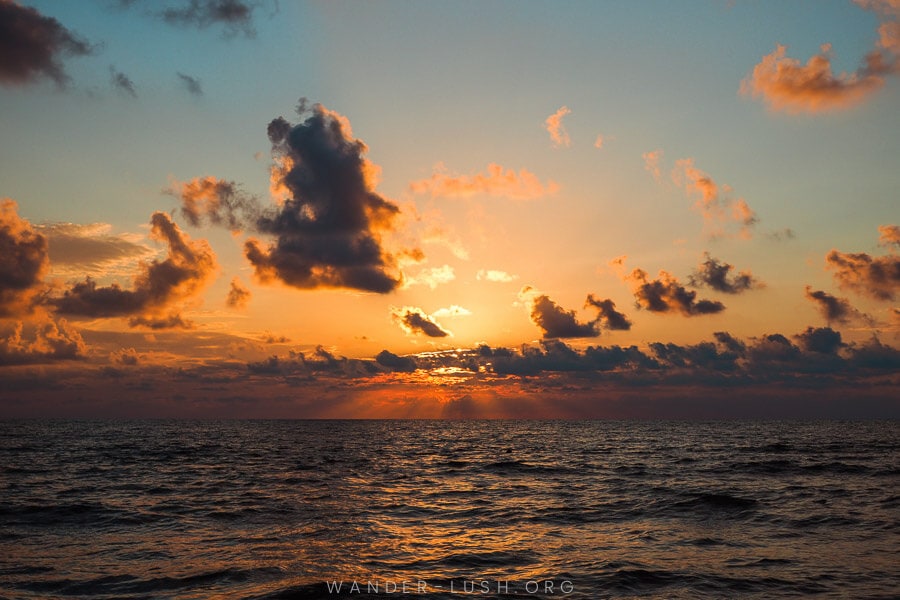
Summer sunset in Shekvetili on the Black Sea Coast.
August in Georgia
Much like July, August brings oppressive heat to most of the country. It even starts to get hot under the collar in Svaneti and Kazbegi.
This is summer storm season in the mountains and the forecast often paints a grim picture – but in reality, downpours usually come in short, sharp bursts towards the end of the day, with clear periods in between.
Tbilisi is full of people and the Old Town especially can feel choked and claustrophobic. The only solution is to set up in the shade by a swimming pool, a tub of your favourite Georgian ice cream (or maybe a bottle of sparkling Pet Nat) on hand.
August is the hottest and most humid month of the year in Batumi, too. Combined with summer crowds that persist until the end of school holidays, it’s far from the best time to visit the Black Sea.
Instead, you’re better off making for the higher mountain ranges. Upper Adjara, Gomismta and Bakhmaro – sealed off in winter – are stunning in summer, their colourful A-frame cottages wreathed in green pastures.
Tusheti celebrates its biggest annual festival, Tushetoba, in August, with displays of folk music, dance, archery, horse racing and sheep-shearing. As with most festivals in Georgia, the exact dates are normally finalised a couple of weeks in advance.
In both Tusheti and Khevsureti, there are cycles of roving festivals that travel from village to village throughout the month of August.
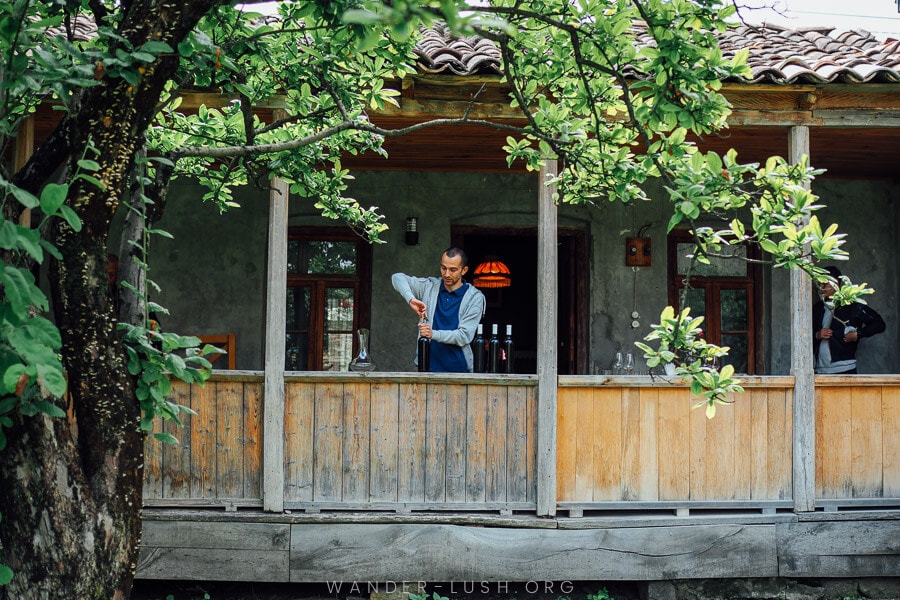
Harvest season is a great time to visit Kakheti.
September in Georgia
September is an auspicious time of year in Georgia as the Rtveli wine vintage formally begins. Harvest dates vary year to year depending on any number of factors. As a general rule, the plucking of grapes starts in the first weeks of September in Kakheti and continues throughout the month. In western Georgia’s wine regions, the harvest starts later and continues into October/November.
One of Georgia’s biggest music festivals, Tsinandali Festival, also takes place in September at the estate in Kakheti.
As summer peak season winds down, many mountain hotels, resorts and wine chateaux offer great deals during the month of September, making the end of the month a terrific time for budget travellers to visit. The start of September is ‘Velvet Season’ on the Black Sea coast, when it’s still warm enough to swim but far quieter. This is a great time to experience the beaches sans summer crowds.
Temperatures remain warm in Tbilisi, but cooler evenings take the edge off. The first of Georgia’s fall colours can be seen in September at higher altitudes around Racha, Kazbegi and Svaneti. Most hiking trails are still open throughout September.

Autumn colours at Dashbashi Canyon in Tsalka.
October in Georgia
In the cities, festival season continues into October while in the mountains and rural areas, people start preparing for the fast-approaching winter. October is one of my favourite months in Georgia.
Tbilisi’s biggest celebration, Tbilisoba (‘Day of Tbilisi’), is normally held on the first weekend of the month and sees the entire Old Town transformed into an open-air carnival. The program includes a gastro market where farmers showcase their produce and wine, and folk performances on outdoor stages.
Meanwhile in Mtskheta, Svetitskhovlobais celebrated every year on October 14 with a street festival and mass-baptism. Both these events are worth timing your travels for.
Weather-wise, crisp temperatures become the norm, and fall colours start to show themselves at lower elevations. The best places for fall foliage include Samegrelo (especially around Martvili), Bateti lake, and closer to Tbilisi near Rkoni, Dashbashi and Birtvisi Canyons, and Sabaduri Forest to the north.
One of the most spectacular October events is the Tusheti sheep drive, when shepherds deliver their flocks from high-altitude summer pastures down into the Alazani valley. Tusheti is well and truly closed to traffic by mid-month.
Kazbegi and Svaneti remain open throughout winter, only ever closing temporarily if there’s an avalanche risk, but it can be quite cold, wet and muddy in the mountains in October. Racha is the best mountain region to visit late in the season, because there are beautiful autumn colours and it’s usually not too wet.
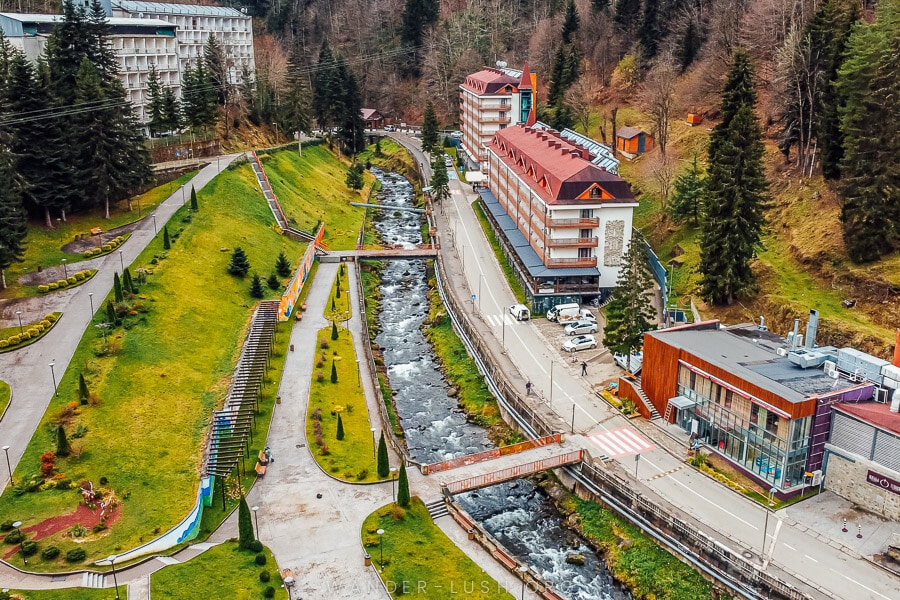
Sairme Restort near Kutaisi in November.
November in Georgia
Come November, temperatures drop dramatically in many parts of Georgia, with daytime averages almost halving in a matter of days. Fall colours linger on in Tbilisi for the first part of the month, making this a nice time to wander the city with your collar up against the wind.
Batumi on the other hand starts to live up to its reputation for being one of the wettest cities in Europe. November is usually the dampest month of the year on the coast. Combined with warm temperatures, it can feel unpleasantly sticky and cloying.
Kutaisi remains warm, while in Tbilisi, dance companies and performers return home after touring Europe during the summer to grace the stages of the Opera Theatre, New Theatre, and other venues.
Winter arrives early in the higher mountain regions, with snow starting to fall in Mestia and Gudauri by the middle of the month.

Winter in Tbilisi.
December in Georgia
By December, the whole country is in full winter mode. Temperatures generally remain above freezing in Tbilisi. This is one of the driest months of the year in the capital, so provided you have appropriate attire, it can be nice to get outdoors and test your mettle on one of the hiking trails around the city.
Kutaisi and Batumi have similar temperatures, but more rain.
Christmas lights and decorations go up in mid-December, with the biggest displays along Rustaveli Avenue, in Freedom Square and on Atoneli Street in the capital. December 25 is a normal working day and goes by without much fanfare in lieu of Orthodox Christmas celebrations in January.
December 31 is a huge affair, with Tbilisi being the best place in Georgia to ring in the New Year.
Final words: When is the best time to visit Georgia?
Georgia offers something different in every season, so when you choose to visit really depends on your interests and priorities.
Remember that the climate and therefore the weather varies dramatically between east and west, the mountains and lowlands.
Here are my general recommendations for when to visit Georgia:
- For hiking & mountains: Late June to September
- For cities & culture: April/May or September/October
- For wine: September/October
- For beaches: July/August
- For skiing & snowboarding: February/March
Overall, September/October and April/May are by far my favourite times of year in Georgia. Even though spring weather can be volatile, temperatures are pleasant throughout most of the country.
Outstanding festivals and events are held during both periods, including Rtveli harvest celebrations in autumn and Orthodox Easter festivities in spring.
You might also be interested in…
The ultimate Georgia itinerary: Four detailed & custom-designed itineraries
Georgia Travel Guide: All of my 200+ posts plus my top travel tips
Georgia travel tips: 25 essential things to know before you go
Places to visit in Georgia: 50+ unique & underrated destinations around the country
The best things to do in Tbilisi: Favourites, hidden gems & local picks
35+ best restaurants in Tbilisi: Where to eat Georgian food
15 best day trips from Tbilisi: With detailed transport instructions
The best time to visit Georgia: Month-by-month guide to weather, festivals & events